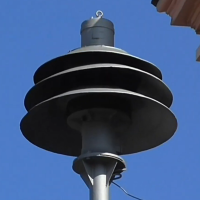Elektror L1/F2: Difference between revisions
ArxCyberwolf (talk | contribs) (Moved page over from the CDS Wiki.) |
(Add image from CDS) |
||
| Line 1: | Line 1: | ||
{{Infobox siren|produced=1940s-19??|company=Elektror Karl W. Müller|type=[[Omnidirectional]] [[Electromechanical]]|title=Elektror L1/F2}}The '''L1/F2''' "'''Kombi'''" is a unique German electric dual rotor, dual tone electric siren that was produced by Elektror Airsystems during World War II and beyond. Intended as the larger cousin of the medium-sized [[Elektror L138|L138]], the siren was larger, louder, and with a different sound. Unfortunately, these sirens have become very rare today as they have been phased out by newer technology. | {{Infobox siren|produced=1940s-19??|company=Elektror Karl W. Müller|type=[[Omnidirectional]] [[Electromechanical]]|title=Elektror L1/F2|image=Elektror_L1F2.png}}The '''L1/F2''' "'''Kombi'''" is a unique German electric dual rotor, dual tone electric siren that was produced by Elektror Airsystems during World War II and beyond. Intended as the larger cousin of the medium-sized [[Elektror L138|L138]], the siren was larger, louder, and with a different sound. Unfortunately, these sirens have become very rare today as they have been phased out by newer technology. | ||
== History and Design == | == History and Design == | ||
Revision as of 04:18, 10 September 2024
| Elektror L1/F2 | |

| |
| Company | Elektror Karl W. Müller |
|---|---|
| Produced | 1940s-19?? |
| Type | Omnidirectional Electromechanical |
The L1/F2 "Kombi" is a unique German electric dual rotor, dual tone electric siren that was produced by Elektror Airsystems during World War II and beyond. Intended as the larger cousin of the medium-sized L138, the siren was larger, louder, and with a different sound. Unfortunately, these sirens have become very rare today as they have been phased out by newer technology.
History and Design
The L1/F2, like most of Elektror's sirens, began production during WWII in Germany. At that point in time, fire sirens were commonplace in Germany, typically being low tone "Woofer" sirens that were often 2 or 3-port. With the threat of Allied air raids, a separate signal was needed to prevent confusion between a fire alarm and an air raid alert. As a result, high tone "Tweeter" sirens were developed. Elektror realized the usefulness of a siren that could perform either function or both at once, leading to the development of the L138 and the L1/F2.
The L1/F2, as its name would suggest, is an Elektror L1 and an Elektror F2 that have been combined into a single siren unit, running off of a common controller. This was done by simply attaching an L1 siren below an F2 by attaching the L1 to the F2's intake supports. Despite appearing to be one siren, the siren is two entirely separate siren units, which can be run independently, or both at once. The F2 is the low tone, or "Woofer", and is a 3-port siren driven by a 1 kW (1.35 hp) electric motor running at 400 V 50 Hz 3 ph, while the L1 serves as the high tone, or "Tweeter", with a 9-port single tone rotor and stator driven by a motor of identical specifications to the former. This results in a 3/9-port siren.
Unlike the L138, where each siren has its own intake, the L1/F2 intakes from the middle of the siren, with both sirens sharing a common intake. This is made possible by using the F2's existing intake, which acts as supports to hold the F2 unit above the L1. Due to the sheer force of the air intake into the siren when one siren unit runs, the other siren tends to spin up despite not being powered on. The low tone side is particularly susceptible to this while the high tone is operating.
The siren's two motors are bare, placed on either end of the siren, with the lower motor including a mounting plate. The upper motor has the siren's eyebolt. To help project the sound and protect the siren from debris, three large skirts are included with the siren. One of these serves as a rainshield for the two rotors while projecting the F2's output, while the middle skirt is where air is drawn in and sound is emitted from the intakes, and the lower skirt projects the L1's output. Mesh screens are also typically included to keep debris out of the siren units, especially on the intake.
Like the L138, the L1/F2 was not a very popular siren. The increased cost and additional maintenance required meant that it wasn't as economical as smaller single rotor sirens such as the FmSi 41, E57, and various other Elektror sirens. As a result, very few of these sirens are known to survive today. At least two or three are still in service today, while at least two are in private possession. The rest are inactive, or were scrapped long ago.